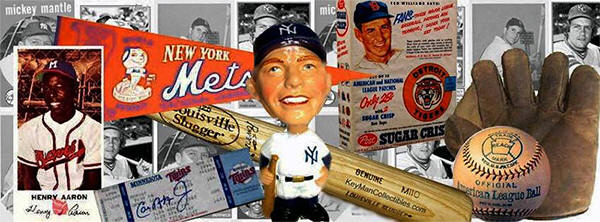In 1892
Joshua Pusey secured a patent for
the compact cardboard match, and
then sold it to the Diamond Match
Company. It took some time to catch
on, but matchbook advertising
became one of the most successful
and cost efficient adverting
mediums of all time. Reaching for a
single matchbook given away to a
patron exposes the advertisement
20-40 times. Baseball was a popular
theme to attract customers to a
product or service.
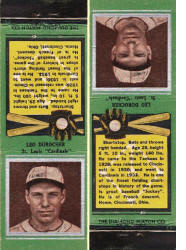
Designated U1 by the American Card
Catalog,
the 1934 Diamond matchbook covers
measure about 1-1/2 x 4-1/8. The
front of the matchbook feature a
sepia tone baseball player picture
pose with a silver boarder. The
cover borders can be found in red,
green, blue or orange. The saddle
(area between the front & back
panels) has the players name and
team.
The back features a short career bio, topped by a crossed bats, glove &
ball design. The inside is blank.
Variations include: 18a -Ralph
Boyle (Error, photo actually Virgil
Davis) 18b -Ralph Boyle (Correct
Photo), 73 -Chas. Grimm (Fielding),
74 -Chas. Grimm (Portrait), and
140a -Lynn Nelson (Error photo
actually Eugene DeSautels) 140b
-Lynn Nelson (Correct photo).
Matchbook Collecting
Terminology:
"Group I" - covers with no
advertising issued in sets by
Diamond during the 1930s, each set
having a particular topic (i.e,
baseball stars, football stars).
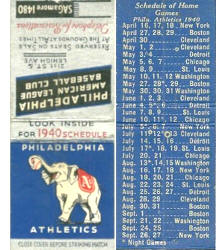
Baseball schedules were
often used by matchbook
advertisers. The idea being after
all the matches are used the
baseball fan, will keep the
schedule for their favorite team,
saving the advertising on the other
side. Distillers commonly used
matchbook schedules, distributing
them to bars where baseball fans
gathered for a drink and a smoke.
Taverns & lounges also used this
medium to promote their
establishment.
There was a time when smoking cigars & cigarettes at the game was
permitted. Cigarettes were even
sold at the ballpark. Some teams
printed their own complimentary
matchbook schedules., and made them
available at the ballpark.
The
Philadelphia Athletes printed such
matchbooks, this style in
different colors with Connie Mack's
White
Elephant, from about
1938-1943. The covers also promotes the
sale of reserved seating.
Matchbook Collecting Terminology:
"Matchbook" - cover with
matches; most collectors strip the
matches out; hence, "match cover"
the foldable card
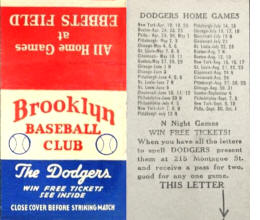
This Brooklyn Baseball Club
"The
Dodgers" 1939 home game schedule
matchbook offers a chance to win
Free Tickets! When You have all the
letters to spell "DODGERS" present
them at 215 Montague Street (Ebbets
Field), and receive a pass for two,
good for any one game.
The letters were hidden under the striker, as pointed out by directional
arrows. The red, white and blue
cover has directions by train.
The Brooklyn- Manhattan Transit lines - BMT, Brighten Beach line to
Prospect Park, and the Interborough
Rapid Transit lines - IRT, 4th or
7th Avenue line to Franklin Avenue.
Matchbook Collecting Terminology:
"Striker" - The abrasive strip on a
matchbook or matchbox upon which a
match is struck.
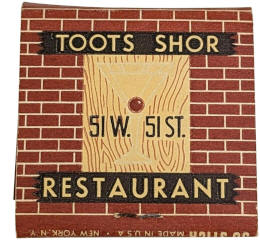
Dubbed as Baseball's unofficial
headquarters,
Toots Shor's Restaurant was
owned and operated by Bernard
"Toots" Shor at 51 West 51st Street
in Manhattan from 1940 to 1959. It
was the place to be in New York
City, frequented by celebrities
such as Jackie Gleason, Frank
Sinatra, Judy Garland, Marilyn
Monroe, Orson Welles, Yogi Berra.
It was also Joe DiMaggio's home away from his hotel room, and a place of
gathering of sports and Broadway
figures, who came to see and be
seen.
In the eyes of Toots Shor, the restaurants glory years were those when the
Yankees, Dodgers and Giants were
riding high in New York. Owner of
the New York Giants Horace Stoneham
was a regular as well. In 1951 Shor
hosted a party held in conjunction
with the National League’s 75th
birthday. Hall Of Famers in
attendance were the likes of Kid
Nichols, Charley Gehringer, Mel Ott,
Rogers Hornsby, Ty Cobb, Tris
Speaker, George Sisler, Pie Traynor,
Mickey Cochrane, Cy Young, Fred
Clarke, Jimmy Foxx and Ed Walsh.
Matchbook Collecting
Terminology: "For Safety"
- footer used on various older covers.
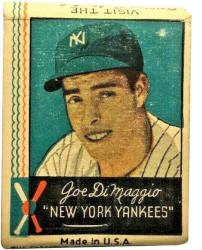 Matchbook from Joe DiMaggio's World
Famous Restaurant & Cocktail
lounge
Matchbook from Joe DiMaggio's World
Famous Restaurant & Cocktail
lounge, overlooking the
world-famous Fisherman's Wharf in
San Francisco. In 1937, a season
removed from his All-Star rookie
season with the New York Yankees,
Joe DiMaggio invested $25,000 in
the restaurant. Named "Joe
DiMaggio's Grotto," he brought his
brothers in, and left Tom in charge
to run the business.
Their farther Giuseppe was a
lifelong fisherman, as were
generations of DiMaggio's before
him. Not long before the restaurant
was opened, the father and older
brothers setout every morning to
take crabs off the ocean floor. Joe
received a wholesale price of 22
cent a crab for his catch.
Matchbook Collecting
Terminology:
"Panel" - a
section of the outside of a cover
(i.e., front panel, back panel).
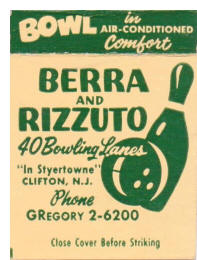
In
1958, New York Yankee greats, Yogi
Berra and Phil Rizzuto put up a
$1,200,000. -
40 lane bowling
center in Styertown, Clifton, New
Jersey. Stars from baseball,
television, radio, and local
political figures, were among the
5,000 who crowded the new Rizzuto-Berra
Bowling Lanes, for it's opening on
March 28, 1958.
Mantle was mobbed by the kids as he walked from the parking lot into the
bowling center as were other Yankee
players on hand, like Don Larsen,
Bill (Moose) Skowron, Hank Bauer,
Bobby Shantz, Tony Koubek, Johnny
Kucks. Gil McDougald, and Manager
Casey Stengel.
They were only a few of the Yankee stars on hand for the opening,
including master of ceremonies Mel
Allen. The establishment also
featured a trophy case, with such
items as American League's Most
Valuable Player Plaques, won by
both Berra and Rizzuto, and a
cocktail lounge shaped like Yankee
Stadium.
Matchbook Collecting Terminology:
"Matchcover" - foldable
cardboard covering for the matches
in a matchbook; also used to
describe a matchbook after the
matches have been stripped out.
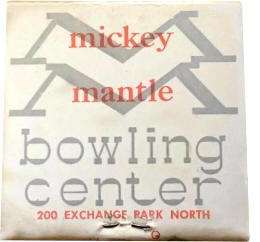 Mickey Mantle opened a bowling
center
Mickey Mantle opened a bowling
center the following year. The
grand opening took place at 200
Exchange Park North in Dallas Texas
on February 7, 1959. The 32-lane
building was a $400. investment,
with Mantle, and his associates
putting up $100,000. and the
Brunswick Company financing the
balance.
The bowling center became part of a contract dispute in 1959. The Yankees
wanted Mantle to take a $15.000 cut
in pay, and Mantle said he
would not take the cut, but
deserved a $3,000. raise to
$75,000. He publicly stated he
would be more than happy to stay in
Dallas and run his bowling alley
rather than accept the pay cut.
Mantle received the raise, and the
following year sold some of his
stock. He stated that he had been
overburdened with absentee
ownership of the lanes, and it was
hurting both the bowling center and
his ball play. Mantle remained as a
major stockholder and the lanes
continued under the name of "Mickey
Mantle bowling center."
Matchbook Collecting
Terminology: "Pressing" -
the process of flattening stripped
covers, often in some sort of
vise-like device.
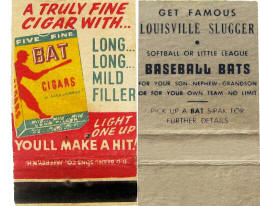
In 1960 the Continental Cigar Company, makers of
Bat Cigars ran a
Louisville Slugger baseball bat
promotion. For only $2.00, and two
empty Bat cigar 5-paks, you had
your choice of a Louisville Slugger
Softball or Little League baseball
bat.
The inside of this 20 strike
matchbook features the offer that
reads; "Get Famous, Louisville
Slugger * Softball or Little
League, Baseball Bats, for Your Son
- Nephew -Grandson - Or For Your
Own Team No Limit, - Pick Up A Bat
5-Pak For, Further Details." The
back of each 5-pak Bat Cigars had
an order form for the Louisville
Slugger offer.
Matchbook Collecting
Terminology: "20-Strike"
(30 or 40) - generic term for
covers with 20 matches, 30 matches,
40 matches, or that sized cover.
Tony Piet was a major league infielder from 1931 to 1938. Piet played for
the Pittsburgh Pirates, Cincinnati
Reds, Chicago White Sox, and
Detroit Tigers. He shortened his
surname, Pietruszka, to Piet
because it couldn't fit on the
Forbes Field scoreboard. After
retiring from baseball in 1938 he
opened what would become one of the
largest Pontiac dealerships in the
World. It covering more than three
city blocks on Chicago's southwest
side, 6603-37 S. Western Ave.

